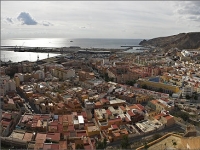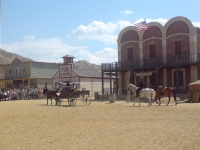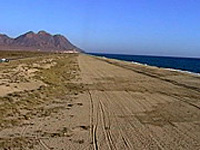Costa Almeria Travel Guide
Blessed with over 200 miles (322km) of coastline along the Mediterranean, Costa Almeria is one of Spain's most enchanting regions, where traditional Spanish culture thrives amid glorious, unspoilt beaches, rugged cliffs and arid scrubland. Visitors will relish this part of southeast Spain, whether they're stargazing from a balcony under some of the clearest skies in Europe, wandering charming villages or dining at fabulous tapas bars.
Almeria still bears the archaeological evidence of many ancient cultures, from the Tartessos and Phoenicians to the Romans and Visigoths, who were drawn here by the natural beauty, and useful maritime geographic location. The region retains a Moorish flavour as well, owing to its closeness to North Africa.
Inland, Almeria is rather barren, and boasts Europe's only desert region around the village of Tabernas, which has been used as the location for several western movies. In the east, the lunar-landscaped Cabo de Gata-Nijar nature reserve, with its dramatic coastline, attracts hikers, birders and scuba divers. Despite the dry, inhospitable landscape, Almeria has developed a thriving agricultural industry, and plastic-covered tunnel farms packed with fresh produce and flowers are prolific.
Most visitors flock to the holiday resorts to the east and west of the lively capital city of Almeria, which itself boasts picturesque squares, some worthy sights, cafes, a ferry port and marina. Lovely beaches, hotels and sport centres provide plenty to keep holidaymakers happy in the resort towns of Mojacar to the east, and Aguadulce, Roquetas de Mar and Almerimar to the west of the city. Almeria is also a gateway to the real Spain, as each of its sunny towns has its own fiesta celebrations, which often honour the religious patron of the village or an ancient tradition. Travellers will enjoy the elaborate processions and colourful parades.
Things to do in Costa Almeria
Apart from the alluring beach resorts and the scenic coastline, Costa Almeria boasts some supremely unusual natural landscapes and the many historic attractions of Almeria City. The region is a delight for movie buffs, as both the city and the desert surrounding the village of Tabernas are favourite locations for film shoots. In fact, the movie sets built in the town are now theme park attractions and, oddly, the European desert is the perfect place to get a taste of the American Wild West.
Almeria is dominated by the massive Alcazaba citadel and has an interesting Old Town and a great archaeological museum to keep culture lovers busy. However, the arid desert landscapes, volcanic mountains and coves, and unexpected wetlands and lagoons are the main attraction of the Costa Almeria, drawing active and adventurous nature lovers to mountain bike, hike and scuba dive in the Cabo de Gata-Nijar Natural Park and all along the coast. The huge reserve also contains some historic ruins, quaint fishing villages and spooky abandoned towns to explore. The picturesque village of Nijar is a particular favourite with travellers and a good place to go shopping for arts and crafts in Costa Almeria.

Almeria City
The ancient Andalusian city of Almeria lies sheltered at the base of a bay, and is proudly dominated by the amazing Alcazaba, a huge Moorish citadel with three walled enclosures dating from 995. A 16th-century Christian castle was built on the foundations of the original Moorish citadel, creating a potent aesthetic mixture of architectural styles. From the citadel, visitors have a good view of the city's most impressive and important Christian monument, the Cathedral. Dating from 1524, its designed more like a fortress than a church because of the need to defend it from pirate attacks. The Cathedral contains numerous art treasures, including a tabernacle dating from the 18th century.

Tabernas
About 16 miles (26km) from Almeria and set between the Sierra de Alhamilla and Sierra de Filabres, the little village of Tabernas is in a barren landscape of canyons and rocky wasteland. A few decades ago, when Western movies were the most popular Hollywood genre, legendary stars such as Clint Eastwood, Lee van Cleef, Claudia Cardinale and Charles Bronson strutted their stuff here in the dry heat on film sets that fans will recognise from movies such as The Good, The Bad and The Ugly, A Fistful of Dollars, and The Magnificent Seven. The movie lots have now become theme park tourist attractions.

Cabo de Gata-Nijar Natural Park
A lighthouse stands at the tip of the Cabo de Gata Peninsula north of Almeria, marking the extremity of Andalusia's largest coastal nature reserve. The park is a fascinating landscape of arid desert, volcanic mountains, jagged sea cliffs, sand dunes, wetlands, a lagoon and hidden sandy coves. Mountain bikers, hikers, bird-watchers and water sports enthusiasts enjoy this natural wonderland, which encompasses some quaint fishing hamlets, historic ruins and magnificent stretches of beach. Two of the most popular beaches are Playa de Monsul, which has picturesque volcanic rock formations, and Playa de los Genoveses, which is within walking distance of San Jose. Tiny rock islands cluster off the rugged coastline and there are extensive coral reefs along the shore.
Spain travel info
Electricity
The electrical current is 230 volts, 50Hz. European-style two-pin plugs are standard.
Language
Spanish is the official language, but English is widely understood in areas frequented by tourists. Catalan, Galician and Basque are spoken in the relevant areas.
Money
Spain's official currency is the euro (EUR), which is divided into 100 cents. Money can be exchanged at bureaux de change and major hotels, but banks give the best rates. All major credit cards are widely accepted at most hotels, restaurants, and shops. ATMs are widespread and are generally the cheapest and most convenient method of obtaining money.
Tipping
Hotel and restaurant bills usually include service charges, but additional tips are welcomed for services rendered. In established restaurants, tips of about 10 percent are expected. Drivers of metered taxis expect small tips and it's customary to tip about 5 to 10 percent for most services, including guides.
Health
There are no health risks associated with travel to Spain, and no vaccination certificates are required for entry. Medical facilities are good but comprehensive travel insurance is always advised. Spain has a reciprocal health agreement with most EU countries that provides emergency health care for EU travellers on the same terms as Spanish nationals. After Brexit, the Global Health Insurance Card (GHIC) replaced the European Health Insurance Card (EHIC) for UK citizens. The GHIC allows UK citizens access to state healthcare during visits to the EU. The GHIC is not valid in Norway, Iceland, Liechtenstein or Switzerland, nor is it an alternative to travel insurance. EU travellers should take a European Health Insurance Card (EHIC). Travellers should take any medication they require along with them, in its original packaging and accompanied by a signed and dated letter from a doctor detailing what it is and why it is needed.
Safety
Most visits to Spain are trouble-free except for occasional street crime. Petty crime, such as pickpocketing and purse snatching, is most common in larger cities, particularly during holidays, festivals and weekends, and especially on public transport and in tourist areas. Thieves may work alone or in groups; visitors should be wary of strangers who offer or ask for help of any kind, or inform them of a stain on their clothes, as these are often ways of providing a distraction for accomplices. There are also scams involving letters for outstanding traffic fines or Spanish lottery winnings. Travellers can avoid incidents if they exercise all the normal precautions.
Local customs
Smoking in public places is banned and stiff fines will be imposed for smoking in areas such as enclosed public spaces, areas where food is prepared and sold, public transport, non-smoking areas of bars and restaurants, and any places that cater for children. Drinking alcohol in the streets of Madrid and the streets of the Canary and Balearic Islands is illegal.
Doing business
The business culture in Spain is slowly shifting but, for now, it's entrenched in tradition and it can take some time for foreigners to gain a foothold in the Spanish working world. It's important never to undermine authority as hierarchy is central to Spain's business world. Managers tend to make decisions without considering input from their colleagues.
A strong emphasis is placed on social status, character attributes, and personal pride. Success is often hinged upon being well-dressed, honourable, and dignified, while also exhibiting great social skills. Business meetings are generally conducted face-to-face and can go on for long periods, as Spaniards prefer long deliberations in order to avoid uncertainty in corporate dealings. Business meetings in Spain tend to tread a fine line between personal and formal.
Conducting business in Spain can entail navigation through a lot of red tape and bureaucracy. Spanish is the language of business, but some of the larger multinationals conduct meetings in both English and Spanish. Business hours are often quite varied, but generally open by 9am and close in the mid-evening with a two-hour lunch break during the early afternoon.
Business attire is quite conservative with men wearing dark or linen suits, shirts and silk ties. Women should wear modest dresses or tailored suits. Brand names or labels attract affirmation from colleagues and associates.
After the conclusion of successful negotiations, gifts are appropriate. Gifts should be of high quality and, when receiving a gift, it should be opened in front of the giver. Business cards are important and should be bilingual. Meetings are best scheduled for mid-morning, and establishing a formal yet personable environment is important before beginning. Meetings often occur over lunches and dinners.
Duty free
Travellers from EU countries are allowed the following items duty free: 800 cigarettes or 400 cigarillos or 200 cigars or 1kg tobacco; 110 litres beer; 90 litres wine; and 10 litres spirit. Travellers from non-EU countries may have 200 cigarettes or 100 cigarillos or 50 cigars or 250g tobacco; 1 litre spirits, 4 litres wine, and 16 litres beer.
Communications
The international access code for Spain is +34. WiFi is widely available; travellers can purchase local SIM cards for unlocked phones or use eSIMs if their cellular providers support it on their networks.
Passport & Visa
The borderless region known as the Schengen area includes the following countries: Austria, Belgium, Czech Republic, Denmark, Estonia, Finland, France, Germany, Greece, Hungary, Iceland, Italy, Latvia, Lithuania, Luxembourg, Malta, The Netherlands, Norway, Poland, Portugal, Slovakia, Slovenia, Spain, and Sweden. All these countries issue a standard Schengen visa that has a multiple entry option, allowing the holder to travel freely within the borders of all. Non-EU nationals must hold a return or onward ticket, all necessary documents for onward travel and sufficient funds. It is highly recommended that passports have at least six months' validity remaining after the intended date of departure from Spain. Immigration officials often apply different rules to those stated by travel agents and official sources.
Entry requirements
United States citizens require a passport valid for three months beyond the period of intended stay. No visa is required for stays of up to 90 days within a 180 day period.
British citizens require a passport valid for three months beyond the period of intended stay. No visa is required for stays of up to 90 days within a 180 day period.
Canadian citizens require a passport valid for at least three months beyond period of intended stay. No visa is required for stays of up to 90 days within a 180 day period.
Australian citizens require a passport valid for at least three months beyond period of intended stay. No visa is required for stays of up to 90 days within a 180 day period.
South African citizens require a passport valid for at least three months beyond period of intended stay. A visa is required.
Irish nationals require a valid passport, but a visa is not necessary.
New Zealand citizens require a passport valid for at least three months beyond period of intended stay. No visa is required for stays of up to 90 days within a 180 day period.
Useful contacts
Spanish Tourist Office, Madrid: www.spain.info.
112 (General).Embassies / consulates in other countries
Spanish Embassy, Washington, United States: +1 202 452 0100.
Spanish Embassy, London, United Kingdom: +44 0207 235 5555.
Spanish Embassy, Ottawa, Canada: +1 613 747 2252.
Spanish Embassy, Canberra, Australia: +61 02 6273 3555.
Spanish Embassy, Pretoria, South Africa: +27 012 460 0123 (ext. 116/117).
Spanish Embassy, Dublin, Ireland: +353 01 283 9900.
Spanish Consulate, Wellington, New Zealand: +64 04 802 5665.
Embassies / consulates in Spain
United States Embassy, Madrid: +34 91 587 2200.
British Embassy, Madrid: +34 91 714 6300.
Canadian Embassy, Madrid: +34 91 382 8400.
Australian Embassy, Madrid: +34 91 353 6600.
South African Embassy, Madrid: +34 91 436 3780.
Irish Embassy, Madrid: +34 91 436 4093.
New Zealand Embassy, Madrid: +34 915 230 226.



